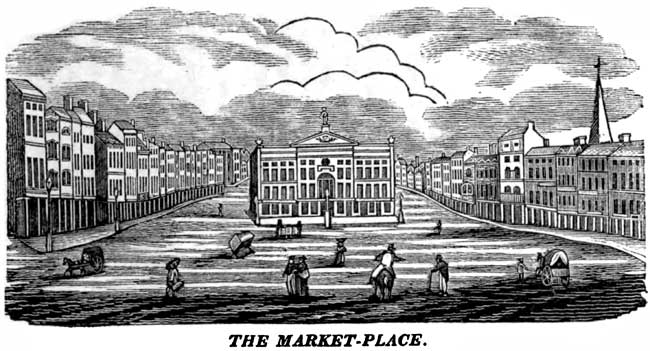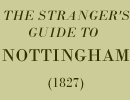< Previous | Contents | Next >
THE
STRANGER'S GUIDE.
Nottingham is one of the most ancient towns in England, deriving its name, as is generally supposed, from the caves cut in the soft yielding rock on which it is built; the word Snottingaham, in the Saxon, meaning a habitation or retreat in the rocks. Historians reckon it to have been a place of residence for the ancient Britons; whether it was one of the Roman stations or not, has been the subject of controversy. So early as the year 866, it is recorded that Nottingham was such a considerable city, that it made a long stand against an army of Danes, which had ravaged the greater part of the north of England, and when the city was at length compelled to submit, it furnished winter quarters for the invaders, so that it must have been a considerable place at a very early period. The excellence of its situation, close by the noble river Trent, the salubrity of its air, together with its manufacturing and commercial enterprise, have caused it gradually to increase, until it has become the ninth town in England, containing a population, including the suburbs of Brewhouse-yard, Standard-hill, Radford, and Snenton, of 49,523, according to the population returns of 1821, and having since that time wonderfully increased, is supposed to be peopled by no less than 60,000 souls!
Many strangers necessarily visit such a town as this, and they want a Guide, to point out to them, those things which are most worthy of observation, and these pages are designed to supply such a desideratum. We will therefore commence with the spacious
MARKET PLACE,
which is justly considered one of the finest in England. It has been newly paved at the expense of the Corporation, in the present year, and contains within its capacious area, 27,515 square yards, or five acres, two roods, and nearly thirty perches, and round it measures 1244 yards, or nearly three-quarters of a mile. Here are held the fairs and markets; the regular market days being Wednesday, Friday, and Saturday, but the latter is the principal one. In the embellishment facing this page, we have given a view of the marketplace, with the spire of St. Peter's church, at the back of the houses on the right, but the most striking feature is what is termed the
EXCHANGE HALL.
This noble looking building faces the west, and is stuccoed to represent stone. The pediment is crowned with a good proportioned pedestal, on which stands the figure of Justice, but divested of her sword and scales, which she formerly held in her hands. A plain stone cornice runs on the pediment and wings, and at each end is a neat vase, with a bold Gholish ornament running round. In the pediment, the town arms, with an oak branch on one side, and an olive branch on the other, is carved in stone, and below this is the clock, the dial being fixed in a stone rim or moulding, with the date 1815, the time when the new front to the Exchange was completed. Below the clock is a handsome Venetian window, ornamented with two elegant Ionic columns. This window lights the noble spacious room, which is 75 feet long,

30 feet wide, and 30 high, with an arched ceiling; there are two smaller rooms on the same line, communicating with the large one by folding doors, and when these are thrown open, they form a room of 123 feet long, and in it we have seen more than 400 persons sit down to dinner. Here public meetings are held, and here also the last election was carried on; and sometimes it is used for exhibitions, amusements, balls, &c. The entrance into this large room is by a flight of steps from Smithy-row, on the north side, nine feet wide, and a smaller staircase leads from the centre room into Exchange-alley, on the south side.
On the north side, also, with an entrance from Smithy-row, is the
POLICE OFFICE.
where the magistrates of the town sit every Tuesday and Friday morning, to determine all cases which come before them. On the same side is also the entrance to the
ARTIZANS' LIBRARY,
which is in a large room nearly at the top of the building. This institution was begun in 1824, and has now upwards of 2000 volumes, which are circulated amongst its members, The room is well lighted, and fitted for the purpose. Its members are above 300, who pay about 7s. 6d. for a ticket, and afterwards the moderate sum of 1s. 6d. per quarter, which entitles them to take out books any time between seven and nine o'clock every evening. The present librarian is Mr. Valentine Kirk. Underneath the Exchange and facing the market-place, are four shops, but the principal part of the ground floor, is laid out in extensive shambles. Quitting the Exchange, and going in a direction towards the west, in Angel-row, which is on the south side of the market-place, is an elegant brick building, with iron palisades before it, known by the name of
BROMLAY HOUSE,
which is said to be one of the best built houses in the town. It was erected by Sir George Smith, Bart., whose son afterwards took the name of Bromley, and was one of the ancestors of Sir Robert Howe Bromley, of Stoke, in this county, and hence the building obtained its name. It was for many years, the Nottingham residence of that distinguished family, and at one time was used as a banking house, then it was occupied by Thomas Smith, Esq. but afterwards falling to decay, it was purchased for the Subscription Library of the town. On entering the building, you find yourself in the hall, which is much admired for its floor and its ceiling, and over the chimney-piece is the arms of the Smiths' family, and the head of a female, supposed to have been intended for Queen Anne. On the left is a public news-room, and on the right is a broad flight of stairs leading to the library room. On these stairs, is a full length portrait, as large as life, of the venerable Dr, Storer, the senior physician in the town; it is an admirable likeness, and was painted by Mr. Barber, whose talents as a portrait painter, do the highest honor to Nottingham, his native place. The library room is in the shape of an angle L . Here is the largest collection of books in the town, consisting of many thousand volumes, in all the various departments of science and literature. Here is also a cabinet of mineralogy, to which additions are constantly making, and the room is adorned with sculptures, paintings, maps, portraits, &c. Amongst the paintings, we may particularise a view of Clifton Grove, which has been immortalised by the pen of Henry Kirke White. This painting, which is from the pencil and does great credit to the talents of a native artist, Mr. I. R. Walker, is over the fire-place, at the west end of the room. Here are also portraits of Henry Kirke White, Lord Byron, Colonel Hutchinson, the Rev. Geo. Walker, Col. Elliott, Sir R. Arkwright, D. P. Coke, Esq., John Smith, Esq., T. Hawkesley, Esq., George Coldham, Esq., Thomas Denman, Esq., Joseph Birch, Esq., and many others, whose names are connected with the local history of this town and neighbourhood. There are one hundred and one proprietors of this library, a share in which sells for about £15., and there is an annual payment of £2. The librarian is Mr. James Archer. Strangers can have the privilege of the library for one month, if properly recommended, and introtroduced by a member. One side of the library room is devoted to the reception of the Standfast library, which was given in 1744, by the Rev. Wm. Standfast, D.D. as the foundation of a public library in this town.
In this building there is an excellent billiard table, and the exhibitions of the Nottingham Florist and Horticultural Society, are held in one of the apartments.
